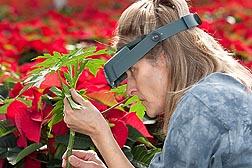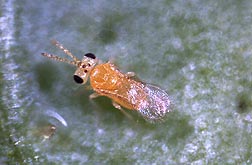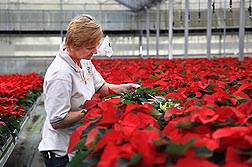Banking on Plants as Storehouses
Tomatoes account for more than $2 billion in farm income nationwide each year. But the silverleaf whitefly (Bemisia tabaci) cuts into those revenues, spreading a virus known as tomato yellow leaf curl virus (TYLCV) that can wipe out an entire crop. To compound the problem, a new biotype of silverleaf whitefly is raising concerns because it is resistant to insecticides and has spread to 26 states since its discovery in the United States in 2004. The threat is taken seriously in Florida, where growers raise up to 40,000 acres of fresh-market tomatoes each year.
Cindy L. McKenzie, an Agricultural Research Service entomologist in the Subtropical Insects Research Unit in Fort Pierce, is showing how growers can combat the silverleaf whitefly and other crop pests by using plants as storehouses for predatory insects that can migrate to tomatoes and other cash crops and feed on the pests.
Choosing the Right Banker
McKenzie teamed up with Lance S. Osborne, an entomologist at the University of Florida Mid-Florida Research and Education Center, Apopka, Florida; and Yingfang Xiao, a postdoctoral associate researcher, to do extensive work showing how papaya, corn, and ornamental peppers can serve as “banker plants” for a range of insect parasitoids and predators. The approach is considered an environmentally friendly alternative because it reduces insecticide use and offers growers a low-cost, self-perpetuating alternative, McKenzie says. The predators eat what they find on banker plants and then fly or crawl off to find the targeted pest on the cash crop. But before they disperse, most will lay eggs on the banker plants, which extends the effect into subsequent generations. Lower pesticide use also means pests like spider mites, thrips, and whiteflies—known to develop resistance to insecticides—will be less likely to become resistant.
|
|
Many Florida greenhouse operators pollinate tomatoes with bumble bees, and that makes them reluctant to use insecticides. Banker plants can be potted and moved around a greenhouse if a grower wants to spray insecticides in one area and keep other areas insecticide free.
“When you use banker plants, you are tapping into nature’s ability to regulate itself, and that’s an approach that has all kinds of potential,” McKenzie says.
Using banker plants is a balancing act that requires finding the right combination of plant, predator, and targeted pest. Researchers must select insect predators and an alternative prey for those predators, and neither should be able to damage the cash crop. They also need banker plants and predators that will not host or spread diseases like TYLCV to the cash crop.
“You can’t just put the predator in and hope for the best. You need a food source for it—an alternative prey—and you need to be sure that the alternative prey doesn’t become a pest itself,” she says.
In a study designed specifically for Florida’s greenhouse poinsettia operations, the researchers chose papaya (Carica papaya) for their candidate banker plant, and they chose the parasite Encarsia sophia, a tiny, nonstinging wasp whose larvae feed on the silverleaf whitefly. Previous work showed that E. sophia attacks numerous types of whiteflies and that a possible food source for it, the papaya whitefly (Trialeurodes variabilis), does not like poinsettia, and in fact doesn’t seem to like anything but papaya. The researchers also knew that as a Florida native, E. sophia poses no threat to the state’s habitats.
“It’s out there in nature, and people don’t even know it’s there,” McKenzie says.
The researchers also needed to make sure that E. sophia would still feed on the silverleaf whiteflies after eating the papaya whiteflies. So they observed E. sophia under two sets of test conditions. In one, they essentially forced the wasps to eat the targeted prey to make sure they would control it when given no dietary choices. In another, they gave them a choice between the prey they were supplying as a food source and the targeted pest they want to eradicate.
“If they like them both equally, that’s a good thing because it means they can survive on one insect while they control the other,” McKenzie says.
Their results, published in Biological Control, show that E. sophia has an appetite for both the alternative prey and silverleaf whiteflies and that it effectively wipes out any silverleaf whiteflies it finds on poinsettias growing near the papaya banker plants.
This banker plant system is now being tested for application in commercial greenhouse tomato production. The limiting factor in adoption by tomato growers was proving that papaya was not a host plant for TYLCV. In a second paper, in Florida Entomologist, the researchers went a step further, showing that papaya is not susceptible to the TYLCV commonly spread by silverleaf whiteflies and that the papaya whitefly, used as the food source for Encarsia, will not infect the tomato plants with TYLCV because they do not feed on tomato.
Beyond Poinsettias, Tomatoes, and Whiteflies
McKenzie, Osborne, and Xiao have also shown that corn will bank a gall midge that effectively controls the two-spotted spider mite. The gall midge has been previously used as a biocontrol for the mite, which attacks green beans and other greenhouse vegetables. But their work, published in Crop Protection, is the first to show how a banker system can be used to effectively “store” the midges.
The research team is also studying whether different varieties of ornamental peppers can bank a type of predatory mite, Amblyseius swirskii, that is effective at controlling whiteflies and thrips in Florida’s greenhouses. Results so far are extremely promising, and the concept is catching on among growers.
Stephen Mullen, general manager at Knox Nursery in Winter Garden, Florida, was initially skeptical about using insects to control the whiteflies that attack poinsettias in his greenhouse. But the nursery is interested in cutting back on insecticide use. So 2 years ago, as part of a cooperative arrangement with McKenzie and Osborne, he began using a combination of banker plant systems: predatory mites banked on ornamental peppers and nonstinging wasps banked on papaya plants. Though the work is continuing, Mullen is pleased with the results so far. The predators have managed to control the whiteflies largely on their own, so the nursery is using very little insecticide in its production of poinsettias.
“I’m convinced this is working. It is absolutely working,” he says.
The research is funded with grants provided by the U.S. Environmental Protection Agency through the Pesticide Registration Improvement Act and by the U.S. Department of Agriculture’s Floriculture and Nursery Research Initiative.—By Dennis O'Brien, Agricultural Research Service Information Staff.
This research is part of Crop Protection and Quarantine, an ARS national program (#304) described at www.nps.ars.usda.gov.
Cindy L. McKenzie is in the USDA-ARS Subtropical Insects Research Unit, 2001 South Rock Rd., Fort Pierce, FL 34945; (772) 462-5800.
"Banking on Plants as Storehouses" was published in the September 2012 issue of Agricultural Research magazine.









